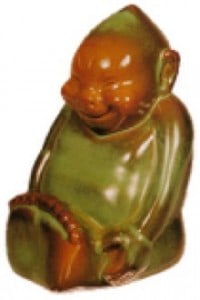 Frankoma’s Billikens, Part I
Frankoma’s Billikens, Part I
by Laura McLaughlin
In my years of collecting Frankoma, I always look at the piece itself (how rare), the glaze color (how long used) pre-fire and after fire, the clay (Ada, Sapulpa, Pink), how it is marked/not marked, as well as any additional features such as sterling silver trim or the rarity of the lunch-box pieces that Frankoma employees made for themselves. And I try to keep informed as much as possible.
The history of the Billiken in the United States began with Florence Pretz, a Missouri art teacher and illustrator, who patented her “design for an image” of the happy creature in 1908, but she was unable to patent the name “billiken,” or its various spellings, because it was already considered a very commonly used word.
What IS the Frankoma Billiken? I have used a lot of resources for this article, trying to answer as many questions as possible. First, the Frankoma Billiken was never allowed to be sold to the general public. I would not classify it as an advertising piece, but more as a memento of a special day, and it was GIVEN ONLY to the participants of that “Mirth is King” or “Book of the Play” day celebration of the Royal Order of Jesters.
I have always had a “billiken” in my life, because my father was in the Air Force and many Air Force pilots flew with a tiny one for Good Luck, especially during World War II. Tiny Billikens were also put in houses that were being built as a protector for the inhabitants of the home.
How I got started collecting the Frankoma Billiken: I began with the 1954, Ada clay, prairie green one that is marked “Jester’s Day, May 7-8, 1954, Host Kenneth Stanley (K.S.) “Boots” Adams.” It was not the billiken that intrigued me at first, it was the man’s name on it, because he came originally from Kansas, attended Kansas University in Lawrence, Kansas, and left school before he would graduate because he was needed at home. In Oklahoma, he began working in the Phillip’s Oil business and rose through the ranks until he became president. He even has buildings named after him. I had written a paper on Famous Kansans with him included.
Then I began to think about the word “Billiken” itself. Per a linguists professor at Kansas University, I discovered that the original word may have come from the Far East, as the name of a sky goddess (dating from about the 14th century), and was possibly corrupted at least twice in spelling, in India and then again in Europe. However, I have not found enough documentation to verify the word history. The billiken below is at Tsūtenkaku, translated “Tower Reaching Heaven,” a well-known landmark in Osaka, Japan. It is located in the Shinsekai district of Naniwaku, Osaka.
From “The Pot & Puma,” Summer/Fall, 1998:
Most Frankoma publications state that Frankoma produced the Billiken from 1951 to 1955. In a newsletter (The American Clay Exchange, Vol. 3, No. 3, April, 1983) Susan Cox recounts information given to her by Leona Thomas of Frankoma. In the newsletter it states, “The Billiken was designed by John Frank (probably from a metal example [Could this have been an original bank?]), brought to him by “Boots” Adams.” K. S. “Boots” Adams (now deceased) was President of Phillip’s Petroleum Oil Company and involved with the Jesters (a fun group associated with Masonic organization). Mr. Frank designed the Billiken, c. May, 1954, and it was produced in Redbud, Black (Onyx Black), and mostly Green (I assume she meant Prairie Green) and sold wholesale for $1.75 each. Approximately 475 were made: 200 went to St. Louis, 100 went to Clayton (Ohio?) [further research indicates an ROJ Chapter in Clayton, MISSOURI, as early as 1942, though no ROJ Chapter in Clayton, Ohio], 24 went to Tulsa, and 82 to Harrisburg, Pennsylvania (69 Billikens are unaccounted for from the total listed here). On Aug. 14, 1978, St. Louis ordered 12 each of the Billikens, in Black (Onyx Black or Flat Black?), Gold (Desert Gold?), Moss (Woodland Moss?), White (White Sand?), Brown (Coffee?) and Yellow (Sunflower or Autumn Yellow?), at a wholesale cost of $4.00 each (A total of 72 Billikens for $288.00). It seems that the Billiken mold(s) were stored for future orders just as Joniece recounts: “After you complete an order, you store usable molds ready for reorders – hopefully which will be forthcoming.”
In that article, I did not see anything about a clay blue Billiken like the one shown below, which I have in my personal collection (of approx. 25), or 2 rubbed bisque Billikens marked St. Louis, 1978.
Left: Prairie Green (Ada clay), “Boots” Adams, 1954; Middle: Crown & belly button jewel, not a wall pocket, hole in bottom; Right: Clay Blue (Ada clay), Tulsa Court.
Of the 547 Billikens mentioned in the article that have documentation showing the Billikens that were ordered, only 478 of the 547 ordered have actually been verified with matching pieces. Though other Billkens (that have no documentation of ever having been ordered) have shown up through later years, it is unknown just how many total Billikens have ever been made (not including any “lunchbox specials;” yes they were made). A longtime Frankoma employee, Kandy McClendon-Steeples, said, in later years, to place an order, Frankoma would require that only one glaze color be used and at least 144 Billikens be ordered before Frankoma would accept the order. So there should be at least 143 other Billikens to match the middle one in the picture above.
Who actually was given a Billiken?
Only a member of the Royal Order of Jesters was given a billiken, when they had their ”Mirth is King” day or “Book of the Play” festival, usually only once a year with a “King” who is the host of the celebration. Per Wikipedia:
“The Royal Order of Jesters is a male fraternal organization,
allowing only Shriners in good standing to join. Admission is
by invitation only. Whereas most Masonic bodies are dedicated
to charity, The Royal Order of Jesters is a fun “degree,” with
absolutely no serious intent. Their motto, “Mirth is King,” is
sufficient to give voice to the purpose of the organization.
The Royal Order of Jesters feels that there are times, after
our hard work and dedication to family and mankind, when
everyone should remember to laugh and appreciate the good
work one has done. The mascot of the Royal Order of Jesters
is the Billiken.”
Older Frankoma Billkens can be found as vases or wall-pockets with hanging holes in the back, all with solid bases. Later Billiken figurines can be found with holes in the bottoms and with no crown, or with a crown on either side of its head, with or without a jewel for its belly button. According to Kandy McClendon-Steeples, the Billiken went through 3-5 physical form changes, so it may be possible to find one that is unmarked and that you have not seen before, as well.
A smaller Billiken, “Bitty”, was manufactured and marketed by Joniece and Donna Frank, marked with their own trademark, Frank x2, and signed by both. More to come on this Billiken in part 2.
The “cream of the cream” is an idiom meaning the “best of the best,” which the ROJ (Royal Order of Jesters) uses. The Frankoma connections to the Shriners (ROJ itself dates from 1911) may be much older than 1954, as a mint bowl I once had in a very rare color has the name “Beauceant” on it. The Social Order of the Beauceant is an order for women of the Eastern Star, an organization of Christian women whose membership is limited to the wives and widows of Knights Templar. It was founded in Denver, Colorado, on February 20, 1890. Members of each Assembly throughout the country work for charities, including the Knights Templar Eye Foundation. The theme of this order is “Faith, Loyalty and Love for God, the Order of Knights Templar and Each Other”. Nothing is known about how this bowl came to be made by Frankoma.
At frankomacollector.com/, Allen Manuel’s website, the Billiken has the mold number assigned by Gary Schaum in his book, Frankoma Pottery, #187. The Frankoma Billiken wall pocket/vase is 7″ in height and usually marked; it has been found and dated from 1954 -1978, though with the variety of glaze colors that Billikens have been found in, I would go with a much earlier date of 1941 and probably past the year 2008. Kandy McClendon-Steeples agrees.
Please note the crowns on opposite sides, and one has a belly-button jewel while the other does not. Some Billikens like this do not have any crowns at all. These are not wall-pockets but rather just figurines with the holes in the bottoms.
The Billkens can be found in Ada or Sapulpa clays, and many more were manufactured after the 1998 “Pot & Puma” article was published. As for markings, they can be found with or without marks. Just because it isn’t marked Frankoma, doesn’t mean that the Billiken is not Frankoma: the glazes, clay colors and image shapes then become identifying factors. Research has led to the following list of Frankoma Billiken lots manufactured over the years:
– Jester’s Day, May 7-8, 1954, Host K.S. “Boots” Adams. Research shows this was for Bartlesville, Oklahoma, only.
– Jester’s Day, Phillip’s Oil Co., Bartlesville, Oklahoma.
– Kansas, Wichita, court # 76 (The court number is often found on the bottom of the Billiken or possibly on the bottoms of the feet; it is NOT a date mark, but the Royal Order of Jesters [ROJ] Court number.).
– Tulsa Court No. 47 w/wo ROJ.
– Muskogee Court No. 99 w/wo ROJ.
– St Louis Court No. 81 w/wo ROJ.
– “POT” on tummy, Mirth is King, Loren Willhoft on bottom. (“POT” is for the potentate or “KING” of Mirth on Jester’s Day; Loren Willhoft was the host of the 1978 Jester’s Day of the St. Louis Court, No 81.) [Lunch-box special??]
These additional courts show up in the ordering records of Frankoma:
– Clayton (suburb of St. Louis), Missouri.
– Harrisburg #116, Pennsylvania.
From “The Pot & Puma,” Summer/Fall, 1998, article, glaze colors that Billikens have been found in and documented are (I added the years the glaze was available):
Onyx Black = (1933-????)
Prairie Green = (1939-????)
Desert Gold = (1939-????)
White Sand = (1942-????)
Redbud = (1949-1954)
Sorghum Brown = (1951-1954)
Clay Blue = (1953-1961)
Buckskin Tan = 1954 only
Saddle Brown = 1954 only
Terra Cotta Rose = (1955-1957)
Sunflower Yellow = (1958-1960)
Brown Satin = (1958-1994)
Woodland Moss = (1960-1978)
Peach Glow = (1962-1974)
Flame = (1964-1992)
Flat Black = (1973-1975)
Coffee = (1973-1988)
Rubbed Bisque = (1973-????)
Autumn Yellow = (1975-1990)
Freedom Red = (1976-1978)
Robin Egg Blue = (1979-1992)
Considering the variety of possibilities there might be, surely more than just 550 total Billikens were made; the ROJ is a very private organization, so researching has been a slow process. I myself have 25+ Frankoma/Frank x2 Billikens, so I would guess, using the information of the ones that are in private collections that I know about, 5,000+/- might be a more accurate estimate, but the earlier the year, the smaller the order and the fewer colors/courts available to collect. If there was only one order from all the different courts that are known to have ordered, easily over 1,000+/- could have been made. The ROJ of Oklahoma all have founding dates around 1941, so that would drive up the estimate as well.
I would really appreciate any information and/or pictures readers might have on the Billikens. Though records show that fewer than 550 Billkens were produced in total from 1941 to 1978, no other information on Billiken orders is available. I disagree that there were only 550 made; we can assume that Billikens were made without documentation or documentation was lost. Proof of the existence of Billkens (glaze color, clay color, any marks) will raise the value, as many Billikens have been made WITHOUT any marks of Frankoma on them.
This Billiken is located outside at St. Louis University, St. Louis, Missouri.
Billikens have value not only for Frankoma collectors but also for the Masons and Shriners. Shriners who belong to the ROJ are the crème de la crème or the “Best of the Best.” They have paid their dues and are ready to play. Since the Billiken is their mascot, owning one or more gives them cachet [being respected or admired; prestige]. Since the Billiken is also the mascot for St. Louis University, St. Louis University High School, and both Jesuit institutions located in St. Louis, there are many alumni who could be collecting them. In the past, the Billiken has been the mascot for several minor league professional baseball teams, including the Fort Wayne Billikens of the 1908–1910 Central League, the Montgomery Billikens of the 1910 Southern Association (a Class A league that ran from 1902–1935), the Bay City Billikens of the 1911 and 1912 Southern Michigan League (a league that had several classifications between 1906 and 1912), and the McLeansboro Billikens of the 1910 Kentucky–Illinois–Tennessee League (“KITTY League”), a Class D professional baseball league that ran from 1903 until 1955. Also, at the Alaska-Yukon-Pacific Exposition in Seattle in 1909, Billkens served as the expo’s “patron saint.”
With so many different possible Billiken collectors out there, finding a Billiken could become a rare event, indeed. But the more knowledge shared about the Frankoma Billiken, the more we will know what to look out for when we are out just visiting thrift stores and antique shops. One last point on the Billiken: To buy a Billiken gives the purchaser good luck, but to have one given to you is even better luck. Scott Trucker has a lot of good luck coming his way.
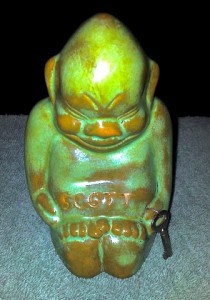
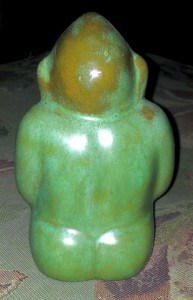
Scott Trucker has his own “Bitty” from
his “cuzins,” Joniece and Donna Frank.
Documenting your antiques and collectibles properly is very important. I highly recommend taking the time to do this, no matter how small or large your collection is. This could save you a lot of time and hassle. If you ever make an insurance claim for antiques and collectibles, most insurance companies will have an appraisal done. They will usually hire an outside appraiser to come in and appraise your items. If your items are destroyed in the disaster the appraiser will have a difficult time getting an accurate value of your items if you do not have your own proper documentation of your collection. Your documentation may be the only thing the appraiser has to authenticate your claim. If the appraiser cannot find ANY published information on the item itself, as well, it will have little to no value; this is why it is so important to help anyone who is working on a Frankoma book, article or even the websites, by sharing your collection with them.
To know that if a Frankoma something does exist and the Frankoma collector does not have it, now they have to have one (or more). Myself, I would hope in the future that Frankoma authors, specialize more. How about dinnerware, kitchen, advertising? I do remember one book on collecting (not Frankoma) that came out that had very few pictures, and the ones that were in the book were black & white. Because the authors were not collectors themselves, they lost their target audience, the collectors, by having items that everyone already had written about before, as well as black & white photos. The book had only one printing.
I would appreciate any information (pictures, color, clay) you want to share or questions you want to ask regarding YOUR Billikens to be sent courtesy of this website, so that I can add it to the information that I am preparing for Part II on Frankoma’s Billikens.
Resources:
Joniece Frank
Kandy McClendon-Steeples
Scott Trucker
James Molter, Jr.
“The Pot & Puma,” Summer/Fall, 1998
Susan Cox
Frankoma and other Oklahoma Potteries by Phyllis Bess
Frankoma Pottery by Gary Schaum
Wikipedia
KU Languages Department
Allen Manuel’s website, frankomacollector.com
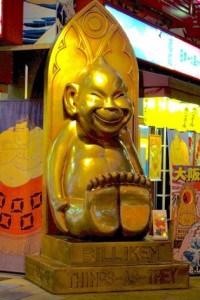
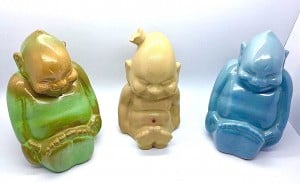

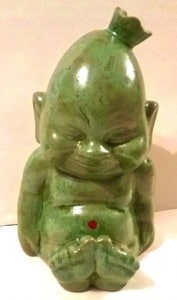
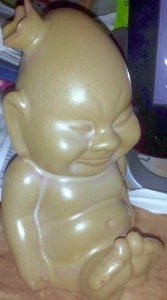
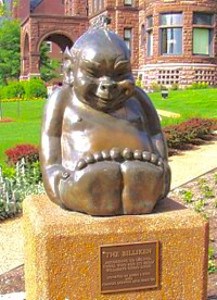








Just bought one today that was signed. Was excited to find the piece. Wanted to find out more about it.
Good find! and thanks for using our website. Ken
I found one at an estate sale in May. Book of the Play, Tulsa Court 47, from 2004. Red “jewel” in the belly button. Thanks to your article I was able to figure out what it was.
Great find! Thanks for sharing and thanks for using our website. Ken
How lucky to have found this page! I was long ago given one of these glorious billikens you reference. I have been curious about the Jester’s Day inscription for such a long time. Not being a collector, I so appreciate the shared details of your extensive research.
Thanks for your comment and kind words. We love to share Frankoma Billiken stories and encounters. Ken
Found one of the 1954 Jesters in Wichita, KS, in a box of Shriners decanters, June 6, 2024.
Great find! Thanks for sharing it with us and thanks for your message from our website. Ken
I have one in green Court 81 found in St. Louis, Missouri
Great find! Thanks for sharing it with us. Ken